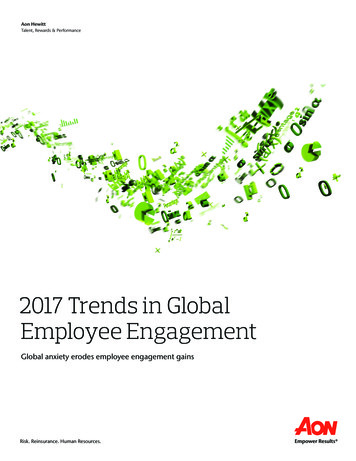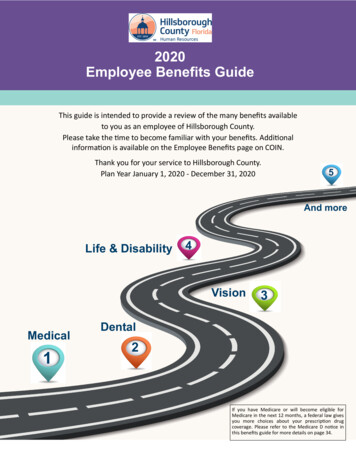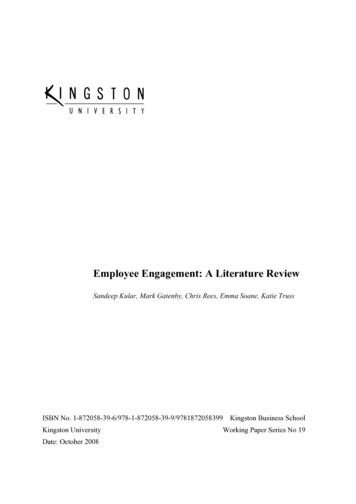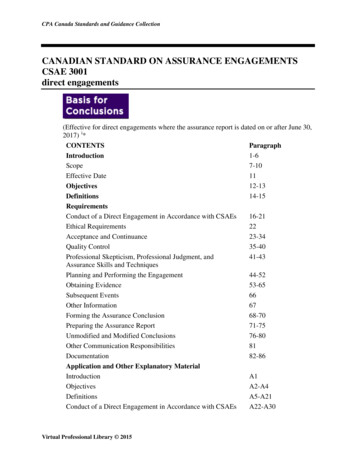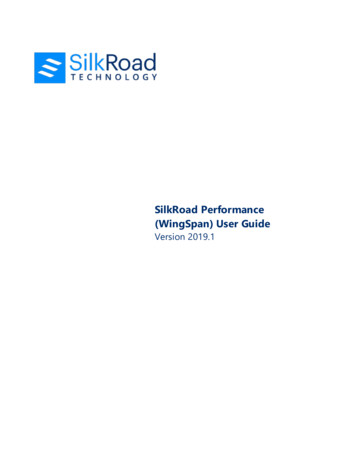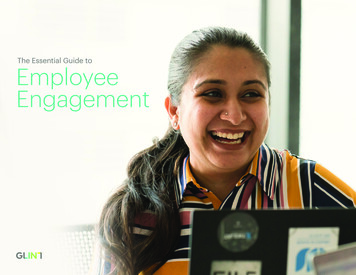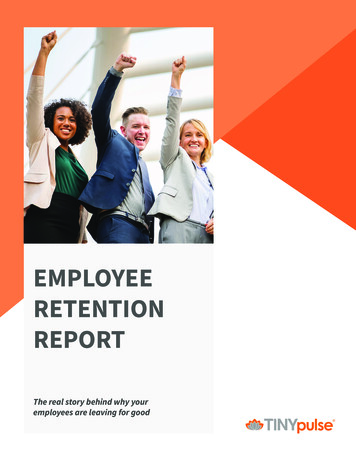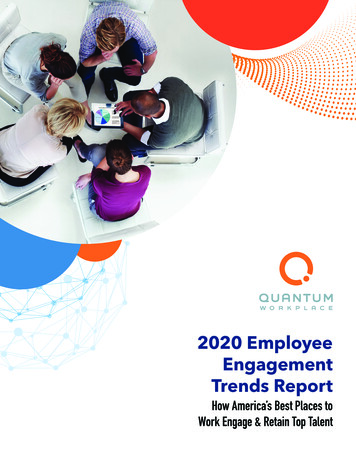
Transcription
2020 EmployeeEngagementTrends ReportHow America’s Best Places toWork Engage & Retain Top Talent
Table of ContentsIntroduction . 3Chapter 1: Engaging Your Talent . 6Defining and Measuring Employee Engagement . . 7The Current State of Employee Engagement . 10Creating an Inclusive Workplace . 15Leveraging Employee Engagement to Boost Team and Business Success . . 19Chapter 2: Leveraging Your Talent . 22Managing Employee Performance Effectively . 23Setting Goals that Get Results . 28Optimizing Performance with Effective Management . 32Leveraging the Power of Teams . 36Chapter 3: Understanding Your Talent . 39Building an Organization that Attracts Top Talent . . 40Architecting a Comprehensive and Continuous Employee Listening Program . 46Using People Analytics to Improve Organizational Action . 50Moving from Understanding to Action . 53Chapter 4: Retaining Your Talent . 56Why Top Talent Leaves . 57How Employee Engagement Impacts Turnover . 61The True Cost of Turnover . . 65How to Reduce Unwanted Turnover . 68Conclusion . 72About Quantum Workplace . 732Make work awesome.quantumworkplace.com hello@quantumworkplace.com
A Message from our CEOIt’s my pleasure to share with you Quantum Workplace’s 10th annualEmployee Engagement Trends Report.Employee engagement is more important now than it ever was duringpre-pandemic times. As our workplaces undergo complete disruption,employee retention, advocacy, and discretionary effort become criticalto the success of our businesses. The interweaving of engagement andperformance measures becomes key to driving individual and teamGreg HarrisCEOQuantum Workplacesuccess. And demonstrating the ROI of our talent initiatives becomesessential to the existence of our programs.Despite these challenging times, we’ve found that the aspects ofemployee engagement and performance that enable individual, team, and organizational success remainrelatively constant. In other words, employees still crave (and require) the same workplace components tobe engaged and successful – even during the worst of times.In our most robust analysis yet, we dive into how America’s Best Places to Work have been attracting,engaging, and retaining top talent. We couple that analysis with external economic and workplace trends,real-life case studies, and our employee engagement experts’ advice so you can turn these insights intoaction in your own workplaces.I hope this report gives you new insight and ideas into how to engage your talent, motivate highperformance, and drive employee success in 2021 and beyond.Learn how Quantum Workplace can help your employees, teams, and business succeedat quantumworkplace.com/succeed.3Make work awesome.quantumworkplace.com hello@quantumworkplace.com
Quantum Workplace’s10th AnnualEmployee EngagementTrends ReportOver the past 20 years, Quantum Workplace has collected millionsof data points about the employee experience. This is the 10thinstallment of our Employee Engagement Trends Report based onthe Best Places to Work national contest data.For more than a decade, we have partnered with workplacesacross the United States to measure the workplace experiencesof organizations that successfully attract, engage, and retaintop talent.Best Places to Work Database Established in 2004 43 cities in 27 states More than 5 million surveysin 51,000 organizations since 2015What’s InsideIn this report, we will focus on how successful organizations getthe most out of their talent throughout the employee lifecycle. Wewill spotlight what these organizations do differently and pinpointevidence-based practices that lead to successful teams andorganizations.The report is comprised of four sections that will help youunderstand trends and best practices around: Engaging your talent Leveraging your talent Understanding your talent Retaining your talentEach section includes trends, strategic employee success advice,insights from our workplace insights experts, and highlights fromEach year, we collect and analyze employee perceptions fromsuccessful companies. The content of this report will help you focusour research and insights enable us to understand workplaceemployee and business success in 2021.thousands of organizations. From this unique vantage point,trends that matter and supply insights to help otherorganizations succeed.4Make work awesome.quantumworkplace.com hello@quantumworkplace.comon improving your engagement programs and strategies to drive
Key COVID Events andWeekly Employee Engagement% Highly EngagedWHO declaresglobal %JAN JAN 2922-28 - FEB 476%FEB5-11JANUARY1st UScommunityspread case;Stock marketdeclines73%FEB12-1870%The Impact of theCOVID-19 CrisisCOVID-19 has rapidly disrupted our lives, economies, andworkplaces in 2020. Our initial analysis of our 2020 Best Placesto Work data revealed that this crisis has deeply impacted theemployee experience.When COVID-19 first hit the United States, employee engagementdipped slightly to 70% highly engaged¹—but then had meaningfulgrowth to 83% highly engaged after U.S. restrictions were put intoplace. This peak was 11% higher than engagement levels duringthe same period in 2019.Due to such diverse work and life circumstances amid thepandemic, it is difficult to point to any one fundamental factor thatmight have affected all employees’ perceptions of work equally.However, key hypotheses surfaced as possible explanations for thestate of employee engagement during COVID-19.Learn more about our hypotheses here:The Impact of COVID-19 on Employee Engagement1. The Impact of COVID-19 on Employee Engagement, Quantum Workplace574%Make work awesome.quantumworkplace.com hello@quantumworkplace.comUnemploymentrate 14.7%Strict USlockdownguidelinesbegin100 UScases73%FEB FEB 26 MAR19-25 - MAR 3 4-10FEBRUARYUS hasmost cases(84k)WHOdeclarespandemic81%78%MAR11-17WHO 1-71Mcases inthe US80%APR8-1415 statesloosenrestrictions79%APR15-2174%76%APR APR 2922-28 - MAY 5APRILMAYThere will certainly be lasting effects of this global crisis tothe workplace—a recovering labor market, a transformation tomore remote work, and a rethinking of crisis response plans,among others.It is difficult to predict the extent to which our experiences willreturn to normal (or what our new normal might be). But we doexpect that the fundamentals of employee engagement andemployee success will remain constant. Organizations will stillneed to attract and select the best talent—and ensure that thosehigh performers are engaged and contributing to business success.Employee engagement is more important now than it ever wasin pre-pandemic times. Though we acknowledge that COVID-19has disrupted many aspects of the workplace, this report willprimarily be reviewing data, insights, and research from before thepandemic. We will focus on the aspects of employee engagementand performance that enable individual, team, and organizationalsuccess that are constant despite workplace disruption, pooreconomic conditions, and a global health crisis.
Chapter 1:Engaging Your TalentStrengthening Employees’ Mentaland Emotional Connection to WorkThe workplace has drastically changed in 2020. Employee engagementhas become even more important in this new world of work—and it’s notgoing anywhere anytime soon.But many organizations still don’t understand the basic building blocks ofengagement or how to move the needle. This results in poor strategiesthat lead to poor results. For engagement to “stick,” it must be an ongoingstrategy with true ownership, clear commitments, and a direct line tobusiness impact.In this chapter, we’ll discuss:6 Section 1: Defining and measuring employee engagement Section 2: The current state of employee engagement Section 3: Creating an inclusive workplace Section 4: Leveraging employee engagement for team and business successMake work awesome.quantumworkplace.com hello@quantumworkplace.com
Section 1:Defining and MeasuringEmployee EngagementDefining Employee EngagementEmployee engagement creates a sense of focus andTo truly drive employee engagement in your organization, you firstthat employees can perform their best. Aspects suchneed to define it and understand what it looks like. At QuantumWorkplace, we define employee engagement as:The strength of the mental and emotional connection employeesfeel toward the work they do, their teams, and their organization.increases involvement throughout an organization soas performance, goals, recognition, development, andmanager effectiveness are all inextricably linked toemployee engagement.Employee engagement is also often confused with the employeeexperience. Engagement is different than, but related to, theemployee experience, which includes meaningful momentsthroughout the employee lifecycle that either drive or hinderOrganizationemployee engagement.Employee engagement is the primary outcome of optimizingthe employee experience.EMPLOYEEENGAGEMENTWorkTeamMeasuring EmployeeEngagementOrganizations traditionally measure employee engagement withIn an industry full of buzzwords, many organizations have confusedemployee engagement with employee satisfaction and employeeloyalty. But employee engagement goes beyond these concepts.employee surveys. But employee engagement surveys are only onepart of a comprehensive employee listening strategy.An annual employee engagement survey is a powerful tool thatsupplies valuable insight into the effectiveness of your peopleQuick read:What is Employee Engagement?7Make work awesome.quantumworkplace.com hello@quantumworkplace.compractices. But your listening strategy needs to account for the factthat employee perceptions are constantly changing in reaction toorganizational and market changes.
A more comprehensive strategy includes pulse and lifecycleEmployee Engagement Profilesconversations.Based on employees’ responses to our e9 items, we categorize theirsurveys, focus groups, and manager-employee one-on-onelevel of engagement using four employee engagement profiles:In chapter 3, we will discuss how to architect an employee listeningstrategy and tips for using these listeningposts effectively.Quantum Workplace’s e9 Modelof Employee EngagementAt Quantum Workplace, we measure employee engagement usingHighlyEngagedModeratelyEngagedAdvocates who intend tostay long-termFavorable, but somethingholds them backBarelyEngagedDisengagedIndifferent andat-risk for turnoverNegative and disruptivetoward the workplacethe e9 model. This model includes nine core engagement itemsthat measure the relative strength of employees’ emotionaland mental connection with their work, team, and organization.Work My work motivates me. I find my work engaging. I am inspired by the work we do.Highly Engaged. Highly engaged employees have extremelyfavorable perceptions of their workplaces. They are advocatesand intend to stay long term. They lead with discretionaryTeam My immediate coworkers consistently go the extra mile toachieve great results. My immediate coworkers are committed to thisorganization’s overall goals. I feel accepted by my immediate coworkers.Organization It would take a lot to get me to leave this organization. I am proud to work here. I recommend this organization as a great place to work.effort and tend to be among the more productive employees inyour workforce.Moderately Engaged. Moderately engaged employeeshave a positive view of the workplace, but something is holdingthem back from being fully engaged. They may like the workthey do, or their teammates, but might consider leaving for abetter opportunity.Barely Engaged. Barely engaged employees display anindifferent attitude toward their workplace. This group lacks thefocus or motivation to perform optimally and is at risk of leavingthe company.Disengaged. Disengaged employees are negative towardthe workplace and can be disruptive with their concerns. Theircritiques go beyond healthy feedback and are not intended to builda better workplace. These individuals often negatively affect theproductivity of those around them.8Make work awesome.quantumworkplace.com hello@quantumworkplace.com
From Insightsto ActionActionable Advice from ourEmployee Engagement ExpertsDefining and measuring engagement isn’t a straightforward process. Engagement ismultifaceted—much like humans. It is a combination of employees’ connections to thework they do, the people they do it with, and the organization they do it for.Because employees change over time, it’s important to implement multiple listeningcheckpoints throughout the employee experience. Here are a few tips to get you started.1.Define engagement and success. Use a clear definition of employeeengagement in your organization. Confusing engagement with employeesatisfaction or employee experience can make measuring engagement (andacting on it) less effective.2.Create an annual baseline. An annual employee engagement surveyis a must for getting a robust understanding of engagement in yourorganization. Include survey items that capture employees’ engagementwith their work, team, and organization.3.Incorporate many channels for employee listening. Employeeengagement varies throughout the year—and you need tools to help youstay on top of it. Supplement your annual engagement survey with pulsesurveys, lifecycle surveys, focus groups, and one-on-one conversations tohelp you take a more continuous listening approach.Return to Table of Contents 9Make work awesome.quantumworkplace.com hello@quantumworkplace.com
Section 2:The Current State ofEmployee Engagement3 Out of 4 Employees areHighly Engaged with Their WorkThough one may view these stagnant employeeAccording to our 2019 Best Places to Work data, employeehave been listening to their workforces to improve the wayengagement numbers and conclude that organizations arenot making much progress, there are success stories thatexist within these data points. More than ever, employersengagement remained consistent year over year through 2019.they do business.74% of all employees surveyed (equating to more than half amillion people) were highly engaged. This means that roughly3 in 4 employees have a strong mental and emotional connectionwith their work.% Highly Engaged Employees 2009-2019Highly EngagedMethodology Change*Percentage Make work awesome.quantumworkplace.com hello@quantumworkplace.com201520162017
Pre-Pandemic UnemploymentRates Hit Rock BottomIn the past decade, we have seen a complete recovery of the labormarket from post-recession highs of nearly 10% unemploymentto 3.5% unemployment at the end of 2019¹. Employers have hadto refocus their efforts on improving employee retention and theemployee experience.Civilian Unemployment Rate, PT2002SEPT2004SEPT2006SEPT2008SEPT2010Year1. Civilian Unemployment Rate, U.S. Bureau of Labor Statistics11Make work awesome.quantumworkplace.com SEPT2018SEPT2020Source: bls.gov
Employee EngagementRemains SteadyYear-Over-YearOver the years, Quantum Workplace has collected millions of datapoints about employee engagement and has found relativelyconsistent trends and group differences in engagement levels.Below are some recent findings and our take on those findings.100%Engagement and Position Level90%80%19% Engagement Gap BetweenExecutives and Individual Contributors.70%We have consistently found that employees who are higher in40%Upper level employees are typically salaried and often have upervisorsManagersDirectorsExecutives50%the organizational hierarchy have higher engagement levels.30%different work experiences than individual contributors. Our10%2019 Best Places to Work data found a 19% difference betweenexecutives and individual contributors in the proportion of highlyengaged individuals.Small and Medium Organizations are23% More Engaged than Enterprise.100%Engagement and Firm Size90%80%70%We have also found that smaller organizations tend to consistentlyhave more engaged employees than larger ones. In fact, thesmallest companies (less than 250 employees) have 23%more highly engaged employees compared with the largestorganizations (5,000 employees) according to our data.Employees at smaller organizations may grow strongerrelationships at work and thus feel more connected with their60%89%73%71%69%66% 4,999Employees5,000 Employees50%40%30%20%10%workplaces. These employees might also feel more critical to theirorganizations’ overall success compared with employees of largefirms who might feel more blended into the crowd.12Make work awesome.quantumworkplace.com hello@quantumworkplace.comHighly EngagedBarely EngagedModerately EngagedDisengaged
Employee Engagementand the Future of WorkThe COVID-19 Crisisteam success and engagement. Digital tools have continuouslyimproved and enabled collaboration across geographic distancesand time differences—enabling many employees to have moreworkplace flexibility in terms of where and when they work.The COVID-19 crisis has changed many aspects of the workplace inHowever, this digital environment also has its downsides.in the future of work, or is it a temporary response to the crisis?online to respond to requests in real time. A study by the American2020. The question is: will this transformation be a permanent shiftLearn More:The Impact of COVID-19 on Employee EngagementThe increased use of remote work, the need for personal protectiveequipment, and the reliance on digital communication andcollaboration tools have been the most noticeable changes to theworkplace due to COVID-19. However, it is difficult to estimate theimpact these changes will have on employee engagement and towhat extent these trends are here to stay.A New Era of Technologyand Workplace CultureIn recent years, massive transformations in technology haveaffected employee engagement.Pew Research¹ started tracking smartphone ownership in 2011 andfound 35% of adults in the US owned a smartphone—compared to81% in 2019. Employees are increasingly using their smartphonesto meet with team members and customers, send and answeremail, sign contracts, and share and upload documents.1. Mobile Fact Sheet, Pew Research Center2. Americans Stay Connected to Work on Weekends, Vacation, and EvenWhen Out Sick, American Psychological Association3. The Gig Economy Has Ballooned by 6 Million People Since 2010, CNBC13Because of this, effective technology has become paramount toMake work awesome.quantumworkplace.com hello@quantumworkplace.comEmployees increasingly report feeling that they always need to bePsychological Association² found that more than half of Americanworkers check work messages before and after work, on theweekends, and even on sick days. This “always on” mentality,if not checked, can lead to burnout.Finally, technology and remote work have also provoked questionsabout organizational culture in a digital space and how to helpemployees feel more supported socially.How Talent and TeamsHave ChangedOther changes in the workplace have been around scaling talent tomeet business growth. For instance, the rise of the gig economy3and the increased use of matrix and project teams have broadenedcollaboration capabilities and helped organizations stay agileand efficient. But this model also calls into question who yourteams are and how they get work done together—which can allaffect engagement.
From Insightsto ActionActionable Advice from ourEmployee Engagement ExpertsWhat does the current state of engagement have to do with your success? It’s critical tomeasure engagement using evidence-based models of employee engagement to retaintop talent. It’s also important to keep up with people practices and processes in yourindustry and beyond. Doing so will help you leverage your people (and their engagement)as a competitive advantage.1.Watch for people trends. Business moves fast. Be mindful of business andpeople trends in your industry so you can stay ahead of the game. Identifythe trends that matter most to you and consider how they might impact yourorganization and workforce.2.Choose your comparisons carefully. It’s tempting to compare yourengagement data to industry or competitor benchmarks. But the true focusof your engagement program should be on continuous improvement ofyour employee experience—not on a score.3.Don’t view engagement as a project. You can’t treat employeeengagement as a project with a completion date. When it comes to yourpeople and their engagement, there is no finish line. There will alwaysbe new opportunities and challenges in your organization. Employeeengagement is continuous work—it’s best to commit to the long haul.Return to Table of Contents 14Make work awesome.quantumworkplace.com hello@quantumworkplace.com
Section 3:Creating an InclusiveWorkplaceDiversity and inclusion are top of mind for many organizationalleaders. A recent Brandon Hall Group study¹ shows that 88%of organizations rank diversity and inclusion as a moderately orDiversityInclusionrange of humandifferencesfeelings of belonging,safety, and equitycritically important driver of business results.88% of organizations rank diversity andinclusion as a moderately or criticallyimportant driver of business results.Diversity and inclusion are not only important to business results,but also to employee engagement. When employees feel a senseof belonging on their teams and feel their thoughts and ideas arewelcomed and valued in the organization, they are more engaged.In the workplace, inclusion refers to feelings of belonging,psychological safety, and equity. When employees are on aninclusive and psychologically safe team, they are more likely toshare their input without fear of retribution.Diversity refers to the range of human differences in anorganization or work unit. This can refer to demographicdifferences—such as age, gender, race, or ethnicity—andexperiential differences—such as work function, educationalbackground, or socioeconomic status.Inclusiveness is also strongly related to feelings of equity—that is,feelings of fair treatment and equality of opportunities, resources,and information. Equity is especially important in the workplace as1. 2020 Brandon Hall Group D&I Benchmarking Study, Brandon Hall Group2. The Business Case for More Diversity, The Wall Street Journal15Make work awesome.quantumworkplace.com hello@quantumworkplace.comit relates to task assignments, performance evaluations, as well aspromotion and compensation decisions.Diversity and inclusion do not necessarily go hand-in-hand. Manycompanies can be diverse, but not include those diverse voices inthe conversations and decisions that matter to the organizations.Contrarily, many companies might feel inclusive, but lack diversity.Benefits of Diversityand InclusionMany studies have shown the benefits that increased diversityand inclusion can have on business outcomes. Recent research bythe Wall Street Journal² shows that cultures that are diverse andinclusive are more profitable and return more value totheir shareholders.Other academic and applied research has shown the benefits ofdiversity on team problem solving, innovation and creativity, andimproved customer service.
The Diversity and InclusionPerception GapTips for Evaluating Diversityand InclusionDespite the strong business case and employee supportSo, what can organizations do if they are just starting to focusinclusion, organizations aren’t successful at advocatingsteps that any organization can take to evaluate diversity andfor programs and practices that increase diversity andfor or implementing initiatives.According to our 2019 Best Places to Work data, 89% of employeesagreed that “everyone here is treated fairly regardless of race,gender, age, ethnic, background, sexual orientation, or otherdifferences.”However, 94% of white employees agreed to that item comparedto just 85% of black employees. This shows a disparity in theemployee experience when it comes to diverse employees.Further, the actual levels of diversity in many industries still fallfar below representation in the United States. This is especiallytrue in higher levels of organizations, including the C-suite andboard of directors.on their diversity and inclusion programs? Here are a few firstinclusion initiatives.1. Listen to employees with theintent to change.One of the first steps you can take is to ask employees about theirexperience via pulse surveys and one-on-one conversations withteam leaders.Specific pulse surveys about D&I practices and policies may helpHR leaders pinpoint interventions to improve culture. Addingquestions about inclusion and belonging to engagement surveyscan also help shine a light on perceptions across employee groups.Direct conversations with team leaders can also be a great listeningstrategy when it comes to talking about diversity and inclusionin the workplace. In these one-on-one conversations, managerscan discuss specific issues of diversity and inclusion that affecttheir local team. However, managers need to feel equipped andcomfortable discussing some of these difficult topics.Questions to Ask Do all employees feel that they candevelop in their roles and careers at thisorganization? How do employees’ perceptions of our D&Iprograms impact their engagement? Are we communicating and implementingthe initiatives that will best support allemployees?16Make work awesome.quantumworkplace.com hello@quantumworkplace.com
2. Use analytics to understandprotected classes.3. Review your talentmanagement processes.Chances are your organization is already collecting data andThe processes, systems, and tools by which you select employees,in your organization.impact diversity in your organization. Senior leaders must consideranalytics that are useful in analyzing diversity and inclusionThese analytics do not have to be machine learning and neuraldetermine promotions, evaluate talent, and assess performance allthese approaches through a diversity and inclusion lens.network models or any other advanced statistics. You can answerOrganizations should also review performance management withcomparisons with a combination of employee survey metrics andoften interfere with the accuracy of performance managementmany questions with simple descriptive statistics and groupdata from HR information systems.Quick Read:How to Measure Diversity and InclusionUsing Engagement Survey Dataequity and fairness in mind. Biases and heuristics of all kinds canratings. All evaluations and ratings must be grounded in solidmetrics and clear benchmarks.Biases may also influence goal setting and task assignments atthe team level. Thus, it is important to keep your pulse on thesepractices and review them often to improve fairness, transparency,and inclusivity.One example of this is looking at how many diverse candidatesyou are attracting compared with who you are hiring or howQuestions to AskAnother example is slicing your survey data across teams and How are we recruiting and selecting fordiverse talent?many diverse employees advance in the organizational hierarchy.protected classes.Questions to Ask What is the level of diversity throughouteach level and position of ourorganization? How is the employee experience differentfor employees from protected classesin our organization? Are they equallyengaged in their jobs? Do employees from protected classesget the same levels of recognition orperformance evaluation? Is the goalsetting process the same?17Make work awesome.quantumworkplace.com hello@quantumworkplace.com Are we using selection and promotionassessments that look for “culture fit”? Have we examined our performanceevaluation ratings for bias? Are we using objective evidence-basedapproaches for hiring and promotiondecisions?
From Insightsto ActionActionable Advice from ourEmployee Engagement ExpertsDiversity, equity, and inclusion efforts, much like business outcomes, need to tiedirectly into your engagement efforts. No matter if your organization is just beginningits journey towa
In an industry full of buzzwords, many organizations have confused employee engagement with employee satisfaction and employee loyalty. But employee engagement goes beyond these concepts. Quick read: What is Employee Engagement? Employee engagement creates a sense of focus and increases involvement throughout an organization so

